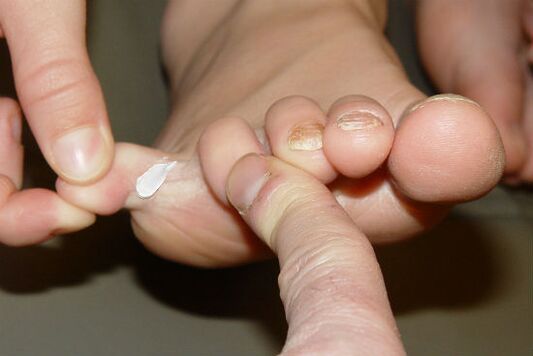
When spores multiplythe fungus spreads to the skin of the feet and nails, penetrates through micro -cracks into the blood and is carried along the bloodstream to all internal organs.
What types of fungus grow on the toes?
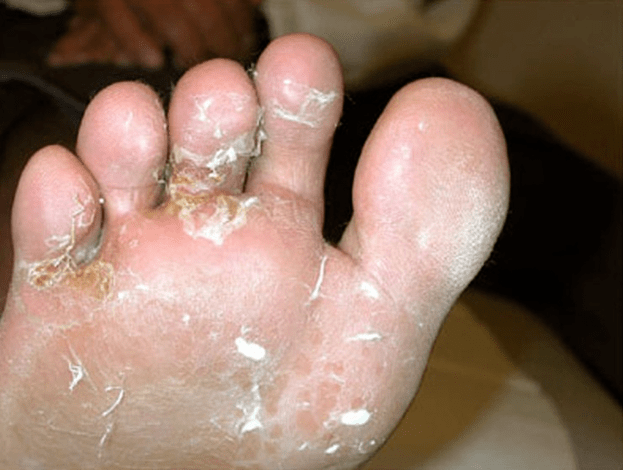
- Mycosis of the toes is caused by the pathogenic anthropophilic microorganisms Tinea pedis. . .
- Less commonly, the causative agents of this disease are molds and fungi such as yeasts of the genus Candida.
- The favorite habitat of the fungus is the folds of skin between the fingers, where it is warm and moist.
- When microorganisms multiply, the spores of microorganisms also spread under the toes, and then to the rest of the feet.
- The main fungal infections occur in public places: baths, swimming pools, saunas, in gym locker rooms.
- Microorganisms perfectly tolerate low temperatures, too dry surfaces, they can last a long time in clothing, carpets, shoes and, if there is an opportunity, adhere to the skin of the feet.
- Often the transmission of organisms occurs in families, when using general hygiene items, slippers, manicure tools.
- Getting on the skin, microorganisms can remain in an inactive state for a long time. The active growth of spores begins with the onset of favorable conditions, that is, with a decrease in the immunity of the infected person
- If spores get on the skin of a person suffering from a chronic disease or who does not adhere to the rules of hygiene, the development of mycosis begins immediately.
- It is especially important for patients with chronic diseases to know the appearance of fungus on the fingers, as they are more often infected with pathogens.
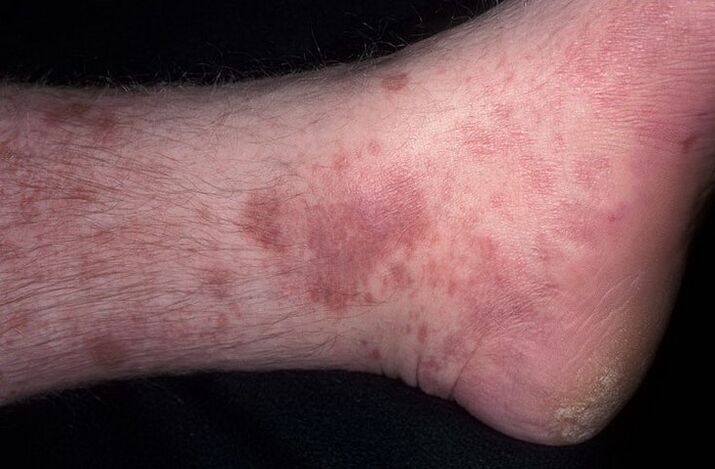
- endocrine system damage;
- poor circulation in the limbs, phlebeurysm;
- Flat feet,contributes to increased skin friction;
- systematic stress;
- periods of hormonal changes in the body: pregnancy, menopause, adolescence;
- inflammation of the lymphatic system;
- after surgery or after traumadecreased immunity. . .
Fungal growth is encouraged by sweating on the feet, shoes made of synthetic materials, and micro injuries to the skin.
Favorable conditions for the growth of spores are created with improper nutrition: abuse of sweets, flour, fatty foods, alcoholic beverages.
In children, toe fungus is rarely diagnosed. The main cause of mycosis in children is lack of hygiene.
Symptoms and forms of the disease
It is possible to suspect the development of infection in the foot at an early stage even before the appearance of visual signs of mycosis.The first sign of infection is peeling and itching of the skin.. . .
When microorganisms begin to invade the epidermis, the surface of the finger becomes covered with small scales and cracks.
An unpleasant odor emanates from the feet. Specific symptoms depend on the form of the disease:
- Deleted.Small and slightly flaky cracks form under the finger and on its surface.
- Squamous-hyperkeratotic. There is severe itching, burning, white crust formation on the fingertips.
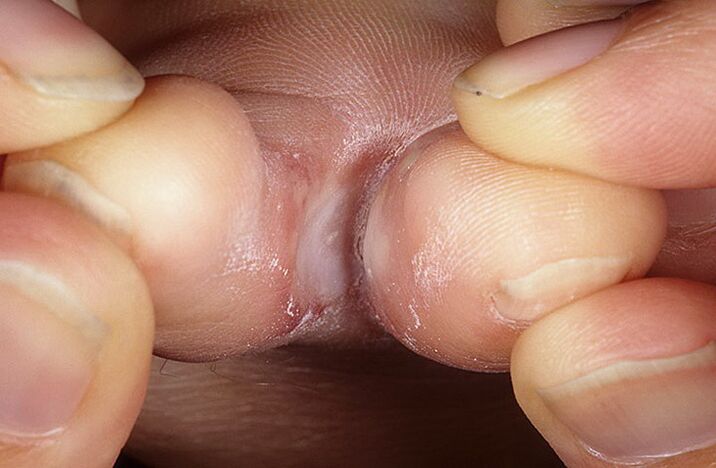
- Intertriginous.There is swelling, redness of the skin, the formation of moisture between the fingers, peeling of the skin, the formation of deep cracks.
- Dishidrotik.It is indicated by a rash of small vesicles filled with serous fluid. Intense itching, erosion formation at the site of burst bubbles, the whole leg becomes inflamed.
IMPORTANT! In the final stages of the disease, the fungus penetrates the surface of the nail and begins to change its color and structure. The nails become covered with colored spots, deformed, crumbling.
Diagnostics
- When the first clinical signs of infection appear, it is necessary to consult a doctor for a diagnosis.
- Despite the fact that the symptoms of the fungus are clearly visible even in photos,only a specialist can identify a specific pathogen.
Patients prescribed laboratory tests:
- Microscopy of skin particles.
- Bacterial cultures of abrasion and fluid from vesicles.
- Biomaterial DNA research.
- Blood test.
Treatment
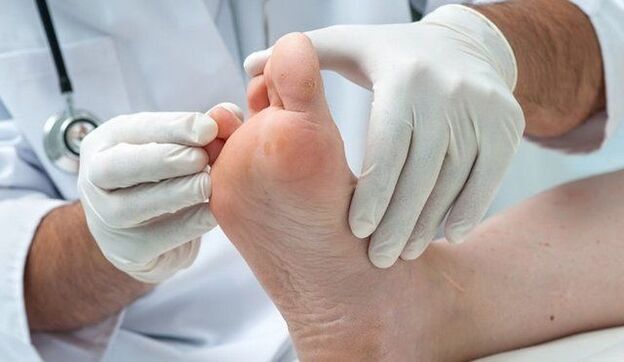
- The main activities are-thorough skin hygieneand treatment with topical antifungal medications.
- In the final stages of the development of a fungal infection, the doctor prescribes antimycotic drugs by mouth.
- In addition to medications, folk remedies and physiotherapeutic procedures are used.
- It is possible to cure the fungus on the toes carefully according to the recommendations of the doctor, without reducing the time of taking the prescribed medication.
Medicine
Drug treatment involves the use of two groups of drugs:
- External preparations: ointments, creams, gels, sprays.
- Preparation for oral administration.
IMPORTANT! The complex of therapeutic measures also includes special diets, taking immunostimulants and ways to restore the intestinal microflora.
Physiotherapy
Physiotherapy procedures are in addition to drug treatment, speeding up the healing process:
- UV radiation on the skin. . . The radiation penetrates the skin to a depth of 0. 6 mm and kills the fungal spores in it. Session duration is 15-20 minutes. In the early stages of infection, the use of UV radiation avoids the use of antifungal agents.
- Diathermy,amplipulse therapy, UHF therapy to improve peripheral circulation.
- Laser irradiation on the skin. . . Skin irradiation blocks inflammation, relieves itching, dries wet areas.
Traditional methods
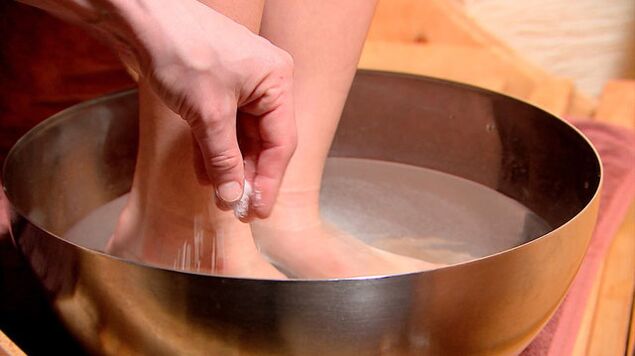
In addition to medicines, prepared according to folk recipes, they are quite effective.
According to reviews, effective help is provided by the following:
- Take a shower with soda and salt. . . 1 tbsp. l. salt and soda dissolved in 2 liters of water, 10 drops of iodine are added. The feet are soaked in the solution for 15 minutes. This procedure is performed before applying the antifungal agent.
- Tray with potato skin stew. . . The broth is soaked in the broth, that is otsuzhenny at a comfortable temperature, for 20 minutes, then washed. This procedure is performed daily until the symptoms disappear.
- Tray with decoction of aspen bark. . . 100 g of chopped bark is poured into 500 ml of boiling water and insist until it cools. The resulting infusion is added to the bath.
- Garlic ointment. . . 2 large cloves of garlic crushed to a porridge state and mixed with 100 grams of butter. The ointment is applied on steamed skin for 10-15 minutes daily for a month.
- The application boilsmedicinal herbs. A series of chamomile and violet, 2 tablespoons each, poured with one liter of boiling water and insist for 2-3 hours. Gauze soaked in the infusion is applied to the inflamed area for 30 minutes daily.
- Compress with burdock leaves. . . Fresh burdock leaves are beaten with a hammer, feet wrapped in them, tied with bandages and socks worn. Compressed changed 2 times a day. The course duration is 21 days.
- Application of carrot juiceand vinegar. 1 tbsp. l. carrot juice and 9% vinegar are mixed and rubbed with a tampon onto the inflamed area.
- Egg ointment and vinegar. . . Raw eggs are poured with 100 ml of vinegar (70%) and insist for 7 days. Mix dissolved eggs with 100 grams of butter, beat. The resulting emulsion is rubbed with steamed feet, wrapped in foil and put on socks. This procedure is repeated daily until the fungus is completely cured.
- Compress with ammonia. . . Add 1 tablespoon to 200 ml of water. l. ammonia, moisten the gauze in the solution, wrap the legs in it and wear socks. Compression is done in the evening and left until morning. The number of procedures is 9-10.
Some interesting recipes for treating fungus. The use of traditional medical methods, necessarily requires the permission of the treating physician.
Complications
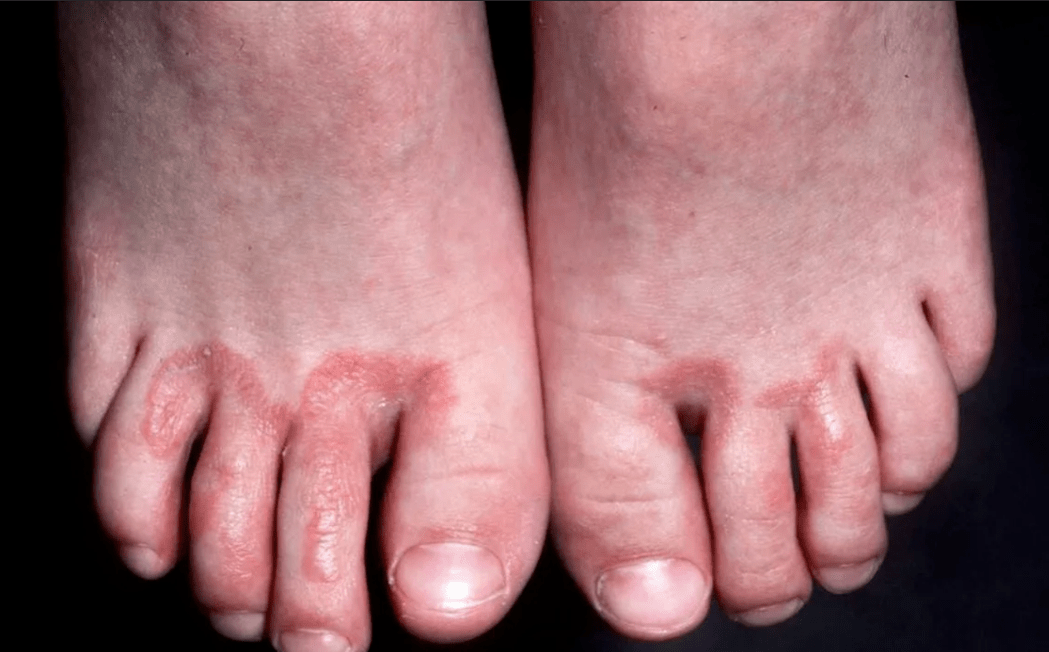
Spreading through the body and penetrating into the bloodstream, the infection affects internal organs, has a negative impact on the overall functioning of the organism:
- Long -term exposure to fungal toxins causes allergic reactions, exacerbation of bronchial asthma, dermatitis.
- Penetration into the blood interferes with the work of internal organs.
- Mycosis in causing the development of diabetes mellitus, and against the background of gangrene and bone infections can develop.
Prophylaxis
Organisms that have a strong immune system are able to fight off any infectious disease. Therefore, the main step to prevent fungal infections is to maintain the body's defenses.
Adherence to hygiene rules will help prevent infection with fungal spores:
- Every daychange socks and tights;
- the use of breathable shoes made of natural materials;
- wear special shoes(slippers, slippers) in public places;
- foot skin treatmentspecial protective spray when visiting pools, baths, beaches;
- do a pedicurein a proven salon,where disinfection of the instrument is carried out properly;
- try on shoes at the storein disposable socks. . . To prevent spores from persisting on various surfaces, it is necessary to treat them antiseptically with a 45%vinegar solution.Wipes and slippers are recommended to be replaced.Treat the rest of the shoes from the inside with a vinegar solution and put in a plastic bag for 12 hours.
- Boil bed linen, socks, tights and towels for 10-15 minutes in a solution of soap and soda.
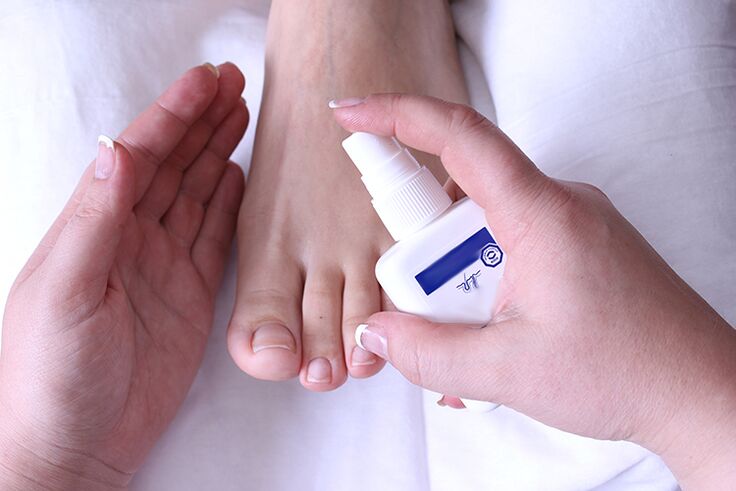
Foot fungus should not be runtherefore, when the first symptoms appear, it is recommended to consult a doctor.
Timely treatment started will allow you to quickly overcome the fungus and avoid complications. It is necessary to treat mycosis until the symptoms are completely eliminated and the skin is restored.
Fungus on the big toe: causes, symptoms (PHOTO) and treatment methods
Nail or foot fungus always starts with the defeat of the outermost toe.
Often, the big toe is the first to suffer, as the nails are the largest in size, but in some cases, the fungus first appears on the big toe.
Such onychomycosis is dangerous by the rapid destruction of the nail plate, which is associated with the small size of the nail on the little finger.
Causes of disease development
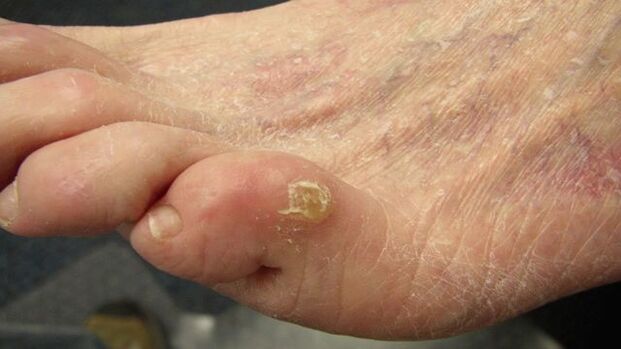
Toenail fungus often begins with damage to the outer toes
Fungus on the big toe is the result of poor personal hygiene when visiting public places. Fungal spores get on the skin in public baths and swimming pools. This is due to the fact that fungi actively reproduce in humid and hot environments.
Another reason for the development of this disease is excessive sweating and microtrauma on the nail plate. In this case, you can get sick when trying on shoes, using other people’s towels or manicure tools.
Fungus on the little finger most often occurs due to contact with an infected person. A careless handshake can cause spores to get under the nail plate.
The main condition for the development of this disease is a decrease in immunity, both general and local. Hyperhidrosis, trauma and damage, circulatory disorders in the legs - all this leads to a decrease in local immunity and increases the risk of infection.
The peculiarity of fungal infections on the little finger is the rapid development of the disease. Onychomycosis is caused by a fungus that eats keratin, which is the building block for nails.
The smaller the nail, the faster the pathogenic microflora will destroy it, destroying keratin, which means that the infection will quickly spread to healthy nails.
If, with a lesion on the nail of the thumb, the disease develops slowly, and symptoms increase over months, with onychomycosis on the little finger, the symptoms become noticeable within a week after the fungal spores enter the bottom of the nail.
How to recognize the disease?
The characteristic symptoms of the fungus on the little finger of the nail depend on the exact localization zone. The fungus can affect both nails and fingers or the interdigital space. In the first case, the symptoms are as follows:
- yellowing of nails;
- nail plate thickening;
- the appearance of grooves and cracks;
- severe nail deformity.
A thick discharge with an unpleasant odor may appear under the nail. Involvement of infection is accompanied by purulent discharge. If left untreated, over time, the nail will completely collapse and peel off from the base of the nail.
When the skin of the fingers is affected, the following symptoms are observed:
- redness of the skin;
- severe itching;
- severe peeling;
- the appearance of an unpleasant odor.
Fungus on the little finger is a serious threat to the rest of a healthy finger, as the spores spread quickly to healthy skin. In further cases, the fungus affects the interdigital space, nail plates, and skin of the feet. All this is accompanied by severe itching and an unpleasant odor from the feet.
Diagnostics
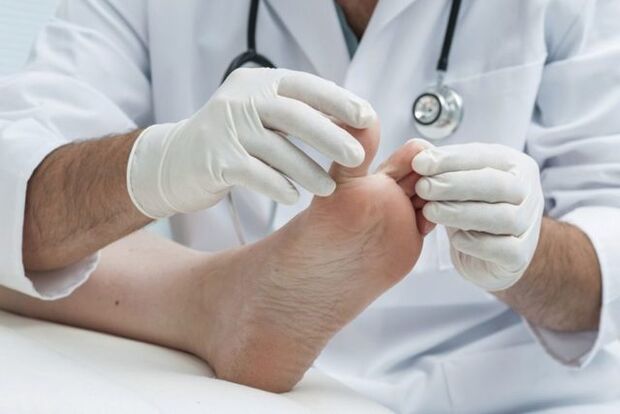
If you notice changes in the nails or skin on the little finger, you should visit a dermatologist. The doctor will examine and take the scrape for analysis. In the event of a skin lesion, the peeling scales are sent to a laboratory, which is easily separated from the skin.
If the nail plate is affected, the doctor will cut a small piece of nail and take a swab of exudate under the nail plate. This material is sent to the laboratory for microscopic analysis. Based on the studies conducted, the optimal treatment regimen was selected.
Principles of treatment
To treat fungus on the little finger, external antifungal agents are used. To get rid of the disease faster, you must:
- monitor personal hygiene;
- frequent foot baths;
- treat the skin around the affected area with antiseptics;
- increase immunity.
To prevent the spread of fungal spores to healthy nails, a separate manicure tool should be used for the affected fingers, disposable files are best. It is important to treat the affected area with special products every day, wash the skin thoroughly, carry out antiseptic treatments and only wear socks and shoes made of natural breathable materials.
Drug treatment
In the treatment of fungal diseases of the feet and with toe fungus, agents for external use are used, complementing the treatment with antiseptic baths. In severe cases, doctors prescribe pills for the fungus.
Only a doctor can choose the right medication after the test. The medications listed are effective against yeast and mold. The cream should be applied twice a day on skin that has been previously washed and dried. In this case, the agent must be applied not only on the affected skin, but also on the healthy epidermis around the infected nail.
To prevent the spread of spores to healthy skin areas, it is necessary to use additional antiseptics. For this purpose, hydrogen peroxide, potassium permanganate or iodine solution is used.
Funds in the form of varnish remain on the nail plate for a long time, ensuring effective destruction of pathogenic microflora and preventing further spread of fungal spores.
Nail fungus treatment takes a long time. On average, the course of therapy lasted for 9 months. You can stop using the drug only after healthy nails have grown.
Before applying the varnish, the nails must be steamed, filed and diluted with an alcohol solution or an alcohol -containing napkin.
In the early stages of onychomycosis on the little finger, you can use a strong antifungal cream. This remedy is used after foot baths and pedicures. In order for the drug to penetrate deeper into the nail plate, it must be carefully sanded, removing all micro cracks.
In cases of severe onychomycosis or if the disease recurs, the doctor may prescribe a pill. They have a systemic effect on the whole body, helping to fight pathogenic microflora from within.
Removing nails
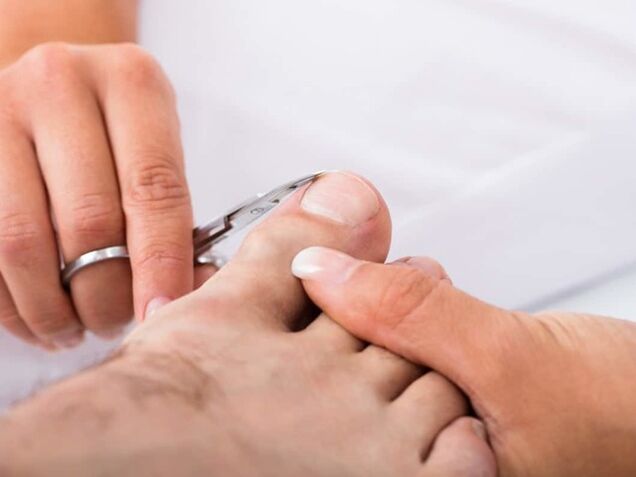
Nails on the little finger are small in size, almost invisible and regrow quite quickly, so doctors can recommend a method of radical treatment - removal of fungal -infected nails. The procedure itself is quick and painless. There are also special kits with uric acid that soften the nails and promote free separation from the base of the nail.
After removing the nails, special ointments and bandages are applied on the fingers. After 5-7 days, a crust forms under the bandage and can be removed. Nails will start to grow back within a month. During this time, it is necessary to use antifungal agents to prevent re -infection.
The benefit of removing nail plates is that it minimizes the risk of contamination of healthy nails. This allows you to get rid of the fungus in a day, but you will have to wait until the nail grows back completely. On average, the nails on the little finger are fully restored in 3-4 months.
Restoration of the people
Folk remedies are advised to use for milder forms of the fungus. They help prevent the spread of spores of pathogenic microflora to healthy fingers, therefore, they perfectly complement drug treatment.
- Lemon juice effectively eliminates yeast. It can be used for nail infections with the fungus Candida, for this it is enough to cover the nails with lemon juice twice a day.
- Fungal paste will help beat the disease. To prepare the product, you must mix one teaspoon of baking soda with the same amount of water and apply on the nails under the compress. Compresses should be kept for half an hour, the procedure should be repeated twice a day until the symptoms disappear completely.
- The basis of folk treatment of fungus consists of bathing. They can be prepared with iodine, baking soda, salt, hydrogen peroxide, boric acid powder, or herbs. For every liter of water, you must take one tablespoon of the selected product. Bathing must be done daily before bed for 20 minutes.
Folk remedies perfectly prepare the skin and nails to use ointments from fungi. As independent drugs, they are not effective, so you cannot rely entirely on traditional medicine.
How to avoid getting infected?
Prevention of fungal infections depends on personal hygiene. You should always use slippers when visiting public baths and swimming pools, do not use other people’s towels or wear other people’s shoes.
If a person has ever been infected with foot fungus, antifungal creams should be used periodically for prevention. For this purpose, it is enough to apply to the skin 1-2 times a week.
Foot hygiene plays an important role in protecting against fungus. It is necessary to wash your feet daily with antiseptic soap or tar, wear only socks made of natural fabrics and choose comfortable shoes made of breathable material.
Fungus between the toes: symptoms (PHOTO), the best ointments and folk remedies for treatment
Among all types of fungal diseases, foot lesions are the most common.
One type of foot mycosis is fungus between the toes. The disease causes severe itching and peeling of the skin, which causes severe discomfort. You can get the fungus in any public place with high humidity.
This type of mycosis occurs in both adults and children.
Causes of disease development
Fungus between the toes is a type of foot mycosis. The disease is contagious and difficult to treat. The course of therapy can last for several months.
Fungus between the toes develops for the following reasons:
- not adhering to foot hygiene;
- visiting public places with high humidity;
- wearing other people's shoes;
- using other people's towels.
The easiest way to get an infection is to go to a public bath without adequate protective equipment. The absence of individual slippers in a shared bathroom, gym locker room, or even in a sauna with moderately high temperatures, can cause a fungal infection between the toes, a symptom picture that will not doubt the exfoliating nature of the skin. .
The development of fungus between the toes of children and adults can be caused by neglect of personal hygiene. Lack of proper foot care leads to the accumulation of sweat and dirt in the interdigital space.
This is a good breeding ground for fungi.
Since some pathogens are always present in the human body, the development of fungal microflora on the skin can occur even without contact with a potential source of infection.
Foot fungus and the skin between the toes are highly contagious fungal infections. You can get sick when trying on other people’s shoes, if that person is infected. This is due to the fact that fungal spores settle on the inner surface of the shoe and easily get into healthy skin.

You can get sick even if a family member is fighting a fungal infection. The fact is that the spores of pathogenic microflora settle on all that come in contact with the affected skin. Spores remain in carpet piles, on towels and on bathroom and shower surfaces. The slightest contact with this object is enough for the spores to permeate into healthy skin.
However, not everyone gets the fungus from using other people’s towels or showers. Factors that provoke the development of fungus between the toes:
- decreased immunity, both general and local;
- the presence of damage to the skin of the feet;
- sweating a lot;
- long -term use of antibiotics;
- frequent stress;
- wearing shoes that are too tight;
- a disease that causes poor circulation in the lower part of the foot.
Long -term drug therapy and frequent stress weaken the body, making it vulnerable to a variety of bacteria and fungi. Wearing narrow shoes leads to a violation of local blood circulation, which reduces the immunity of the feet. This creates favorable conditions for the rapid development of pathogenic microflora.
Foot fungus and interdigital space are particularly susceptible to diabetics, cardiovascular disease and varicose veins in the lower extremities. All these pathologies lead to a deterioration in local metabolic processes and a violation of cellular immunity, thereby increasing the risk of infection with fungi.
Factors that provoke the development of infection include wearing very tight shoes made of low quality materials, synthetic socks and a lot of sweating. All this creates a favorable environment for the development of pathogenic microflora. With a lot of sweat, the process of increasing the fungal population is accelerated, because this microflora likes a hot and humid environment.

Restoration of the people
Traditional medicine knows how to get rid of fungus between the toes. For this, it is recommended to use trays and solutions to treat the skin.
- Pour 2 sachets of boric acid into a basin of water and place on foot for 20 minutes. Apply daily.
- An effective bath for mycosis - 4 liters of hot water, 2 tablespoons of soda, salt and iodine. Take 15 minutes, then lubricate your feet with medicated ointment.
- You can use applications from a solution of soda with vinegar. To prepare the product, dissolve one teaspoon of soda and vinegar in half a glass of water. Then the cotton is soaked in the solution and the skin is carefully treated.
For daily foot hygiene, it is recommended to use tar or laundry soap. They perfectly degrease the skin and have a weak antifungal effect.
Preventing the development of fungus between the toes is thorough foot hygiene. It is important to always bring your own rubber slippers to the pool, gym and sauna. You should not use other people’s hygiene items or try on strangers ’shoes, as they may contain fungal spores.
From all that has been said, we can conclude that foot fungus is a very dangerous disease. The consequences of this disease can be very negative for human health. Do not self -medicate so as not to cause complications.















